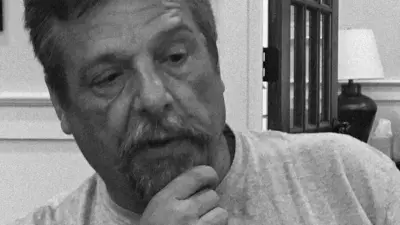We've updated our Privacy and Cookies Policy
We've made some important changes to our Privacy and Cookies Policy and we want you to know what this means for you and your data.
Covid: 'How a picture of my foot became anti-vaccine propaganda'
- By Marianna Spring
- Specialist disinformation reporter, BBC News
Warning: this article contains images that some readers may find distressing
Patricia is suffering from an unexplained skin condition - but a misunderstanding about what might have caused it set off a chain of events that turned her foot into fodder for anti-vaccine activists.
The picture showed purple and red sores, swollen and oozing with pus.
"Supposedly this is a [vaccine] trial participant," read the message alongside it. "Ready to roll up your sleeve?"
Within a day, those same feet had been mentioned thousands of times on Instagram and Facebook. The picture went viral on Twitter as well.
"See they are trying to deliberately hurt us with the vaccine," one tweet read.
The feet belong to Patricia - a woman in her 30s living in Texas. And it's true - she was a participant in a trial for the Pfizer/BioNTech vaccine that started to be administered on Tuesday.
But this is also true: Patricia never received the actual vaccine. Medical records show that she received a placebo, a small injection of salt water. (Researchers do this as a matter of routine, to compare groups that receive a drug or a vaccine with those who receive the placebo.)
Her illness had nothing to do with injections. But that didn't stop activists twisting her story to advance their own agendas. And on top of the physical pain caused by her condition, Patricia received a wave of online abuse.
From misunderstanding to meme
Patricia says her illness began in late October, when she went on a chilly walk. She noticed feel pain in her left foot. Her husband suggested it might be her shoes rubbing.
But when she got home, she found that her sole had become painfully swollen. A big blister had appeared, much too large to be caused by footwear. It was so big that she had to use one of her daughter's nappies to dress it.
When the sole of her other foot also blistered and it became difficult to walk, she visited a number of doctors, who mentioned a number of possible causes.
One of several possibilities they mentioned was fixed drug eruption - a bad skin reaction to a medicine.
Their minds then went to the vaccine trial she was participating in at the time. She had received her second injection five days before the blisters first developed on her feet.
After seeing these doctors, Patricia talked to a relative who was so concerned that she set up a GoFundMe page to raise money for medical bills.
Under America's mostly private health care system, Patricia was already struggling with medical costs due to a back condition. Now she had to take time off from her job as an archival assistant due to her foot sores.
The GoFundMe page made a direct link between the blisters and the vaccine trial. It read: "Patricia... was a volunteer in a COVID-19 vaccine study recently and had a severe adverse reaction".
Image source, GoFundMe
Patricia had agreed with the wording. She didn't realise how it would be used online.
How did the post go viral?
The story spread quickly. After an anti-vaccine influencer posted it, it was picked up in several places, including an apocalypse-themed evangelical Christian site that promotes conspiracy theories about vaccines, the Covid-19 pandemic and the US election.
The site posted a version of Patricia's story along with passages from the Bible describing her feet as having "crusting holes that look a whole lot like the 'grievous sores' described in [the book of] Revelation".
From there it spread to religion-themed and anti-vaccine Facebook groups around the world. Links to the story and the photo of Patricia's feet went viral in Romanian, Polish and Portuguese.
Image source, Facebook
Placebo effect
As word began to spread, Pfizer and Patricia's doctors started looking into her participation in the vaccine trial.
Normally, participants are not told whether they receive a vaccine or a placebo - that information is only revealed to researchers once the study is complete, so as not to influence the results.
But Patricia says that because of the unusual circumstances, researchers and the drug company revealed to her that she had received the salt water placebo, not the trial vaccine.
We independently confirmed that fact, and consulted several independent dermatologists who said a saline solution injected into an arm would not cause a skin condition to flare up in someone's foot.
BBC Trending
In-depth reporting on social media, from the BBC World Service.
After receiving the news, and realising how the otherwise well-meaning GoFundMe page had been portrayed, Patricia was contrite.
"I have to assume some culpability for putting my story out there," she says. "It's social media. You share it for one second and it can get picked up and go viral."
"My injury had nothing to do with the vaccine. My bad. People make mistakes."
Her doctor is continuing to search for the real cause behind her condition.
Image source, Facebook
The spread continues
The newly revealed facts of the story didn't stop misleading information from spreading.
Within a week, Patricia's foot had reached the Twitter feeds of British people with large followings who spread coronavirus conspiracy theories. It ended up in Facebook groups devoted to local areas and parenting, in the US and the UK.
And Patricia got messages from pseudoscience influencers, looking to discuss her story on their YouTube channels.
Beyond Fake News
The best of BBC reporting, education and training to help you understand the challenges posed by misinformation and fake news. READ MORE
She also received a torrent of abuse on social media.
She says people called her "an idiot, a drug addict, a convicted felon, con artist, a person of questionable character and worse."
Anti-vaccine activists sent her angry messages saying she should never have taken part in the trial. At the same time, others sent her abusive messages accusing her of deliberately fuelling disinformation.
Patricia insists she never meant to deliberately deceive. She disabled her social media profiles because of the messages, and says she's particularly upset by the anti-vaccine lobby.
"The fact that these anti-vaxxers are using this to fuel their agenda is infuriating," she says.
Raising money
Patricia still has medical bills to pay. With the help of her relative, the GoFundMe page - which was briefly removed by the site over concerns it was promoting misinformation - is back up, in edited form.
This time, it reads: "Patricia is still suffering from the painful skin condition on her feet; however, the cause has become unclear."
GoFundMe has offered a refund to anyone who donated money under the false impression the injury was caused by the vaccine trial. The page has now raised more than $5,000.
Patricia's story is just one example of a recurring pattern. Fringe activists find a story that seems to supports their entrenched views, and work to spread it rapidly online, regardless of the underlying truth.
For her part, Patricia just "wants this to all be over". She's hoping that her doctor can find the cause of her condition, and that she can get back to work soon.
Subscribe to the BBC Trending podcast or follow us on Twitter @BBCtrending or Facebook.
Top Stories
Features & Analysis
Most read
Content is not available








